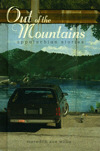Out of the Mountains
Part of the Ohio University Press’s series in race, ethnicity, and gender in Appalachia, Meredith Sue Willis’s collection of short stories, Out of the Mountains, captures visions of life in the rural hills of West Virginia. The twelve stories contained in this volume offer a full range of emotions, from heavy sadness and defeat to joy and rebirth, as well as a full range of characters and even—remarkable for a book defined by place—a pleasant variety of settings.
Part of the Ohio University Press’s series in race, ethnicity, and gender in Appalachia, Meredith Sue Willis’s collection of short stories, Out of the Mountains, captures visions of life in the rural hills of West Virginia. The twelve stories contained in this volume offer a full range of emotions, from heavy sadness and defeat to joy and rebirth, as well as a full range of characters and even—remarkable for a book defined by place—a pleasant variety of settings.
Character is the strength of this collection, and the strongest in an impressive set of individuals is Willis’s Appalachian nurse, Merlee Savage. A divorced single mother struggling to raise two children and earn her college and nursing degrees, Merlee defines the toughness and resilience of a contemporary Appalachian woman. She is featured in several stories in the volume and comes into contact with the other, outside world (New York City) in “Pie Knob” as well as the other, older world of West Virginia in “Big Boss is Back.” In all of these situations, Merlee embodies the resoluteness of the region, as she says, “I’ve never especially cared for the kind of people who go around having conversion experiences every couple of years, whether it’s religion or hair color. People ought to have some consistency, in my opinion.” But consistency does not equate with boredom or even with routine in Willis’ stories, and the characters are forced to grapple with life-changing events as well as their own human nature. Again, Merlee says it best as she describes herself, as well as many other characters in the stories: “One of the things I’ve always been good at is convincing myself I’m doing one thing while I’m really doing another.”
Merlee’s statement is true not just for herself, but for the West Virginia region where these stories are set. Willis is masterful in her ability to present a place that is constantly walking the fine line between past and future, and finding itself always uncomfortable in the present. As she says herself in the collection’s afterword—a short section that is, in some ways, as enjoyable as the stories—the Appalachian region is “about a lot more than whittling and feuding.” Her stories are rooted in the tension between old and new, as when two grown children come back to visit their mother in West Virginia in “Fellowship of Kindred Minds.” They notice a new church “named the Corbin Creek Lighthouse Church of the Full Gospel” and nickname it “the Mini-mega Church of the True Majority.” Throughout this story, the two children struggle to reconcile their present-day existence with what their hometown expects of them. Wrestling with their mother’s religious sentiments in the wake of their father’s death, the daughter says, “I also thought I could really use a glass of wine, but that isn’t part of mourning in West Virginia, at least not in the house. Who knows what the men do out back.” Willis subtly nods to the stereotype of Appalachia—the men with their hard liquor in the shed—while bringing it into stride with the modern-day world. It is moments such as these that make the stories ring true.
Indeed, Willis’s stories are filled with good writing. Particularly as characters grow up and leave West Virginia, becoming pilots in Vietnam or moving to New York City, Willis crafts gorgeous metaphors that relate the bustle of big city life to the staid pace of the home towns. At times, the stories suffer from an excess of telling, particularly at the end. While some stories cut off at that tipping point, leaving the reader with a sense of resolution but still some possibility, too many of Willis’s pieces have an extra paragraph that ties up every single loose end. Although this provides a sense of closure, the endings also feel confining and restrictive. The opening story, “Triangulation,” resists both of these weaknesses. Structured around the orienteering concept that “you locate an unknown point by forming a triangle between it…and two known points,” the piece rotates between three vastly different points of view and ultimately ends with a suggestion: “isn’t it a gift to stand precisely where we stand?” rather than a definite conclusion. This reader wished more of the stories in the volume possessed this variability in form and the tensile strength of the ending.
Willis’s stories are readable and enjoyable: full of engaging plot and rich characters. Strongly evocative of place, these pieces are sure to delight anyone seeking an escape (unless the reader wants to escape rural West Virginia). Indeed, so captivating are the characters in this volume, especially those who crop up in more than one story—C.T. Savage, Roy Critchfield, Merlee Savage—that this reader hopes Meredith Sue Willis will consider finding them homes in more of her writing, perhaps a novel or a linked set of stories.





